If it's really hot and you want to stay cool, you need an air conditioner . There's no way around that, and you'd want to keep your home at optimal temperatures while using the least amount of energy.
But if you don't have an AC, can't install one, or want to reduce AC usage as much as possible, you'll be glad to know there are options to stay cool.
Just remember to temper your expectations. If it's 100F outside, these methods won't get your house down to 75F. But if you're okay with a livable temperature (as opposed to a comfortable temperature), you'll find these workarounds helpful.
Window fans are your best friend when air conditioning isn't an option. They don't cost a lot, don't use a lot of energy (a few dollars a year), and can be surprisingly effective at lowering temperatures.
These days, you'll want to spend at least $50 on a window fan. If you go much lower than that, you will likely end up with a piece of plastic that will bother you, frustrate you, and soon collapse. Trust me, a reasonably quiet fan is worth the extra few bucks!
Other reasons to buy a mid-range window fan:
Bionaire Window Fan with Two 8.5-Inch Reversible Airflow Blades and Remote Control, White Bionaire Window Fan with Two 8.5-Inch Reversible Airflow Blades and Remote Control, White Buy Now on Amazon $54.99 Genesis Dual Window Fan with 9-inch blades, High Velocity Reversible Airflow Fan, LED Indicator Lights Adjustable Thermostat and Max Cool Technology, ETL Listed Genesis Dual Window Fan ETL Listed Adjustable Thermostat and Max Cool Technology, ETL Listed Buy Now On Amazon $49.33
The best way to use a window fan depends on the situation.
If you only need to cool a small, small room, and if the air outside is cooler than the air inside, then close the door and blow in . The cold air will not only reduce the interior temperature, but the circulation will promote evaporation and further cool your body.
If you need to cool multiple rooms, then close all windows except one and blow outside . Ideally, the window fan should be installed at one end of your house and the open window should be on the opposite side of your house.
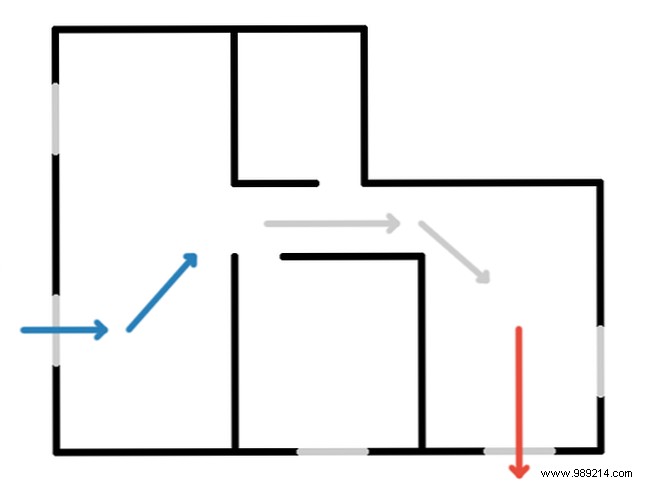
When a window fan blows air outside, it reduces the air pressure in that room almost like a vacuum. Air from another part of your home rushes in to match the pressure imbalance in the room, then air from outside rushes in to match the pressure imbalance in your home.
In other words, blowing air out of one end causes air to be sucked in through the other end, creating circulation through your entire home.
You can add additional window fans to the mix as long as you make sure to maintain a single flow of air throughout the house. All the fans at one end should be sucking, and all the fans at the other end should be blowing. If you mix the flow, the hot air will be trapped inside.
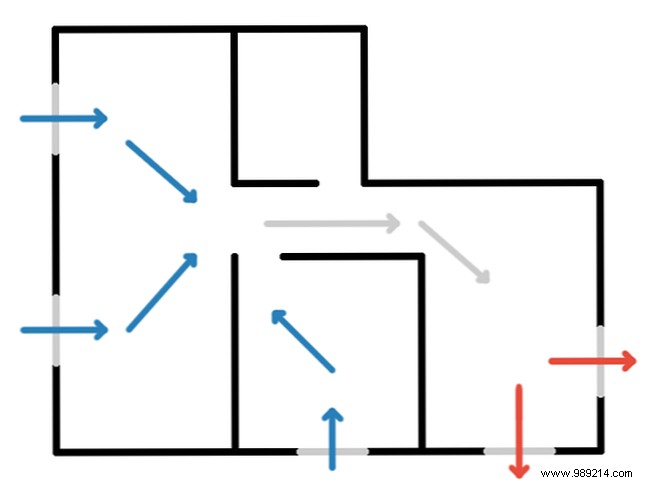
If you live in a multi-story house: Place inward blowing fans at the bottom level and outward blowing fans at the top level. Hot air naturally rises and you don't want to fight that.
Pull over and close all windows as soon as the outside temperature starts to rise. Hopefully your home is insulated enough to keep you cool throughout the day, at least until the outside temperature drops again. Then you can reopen your windows and cycle again.
Pedestal fans are great when paired with air conditioners. 11 Air Conditioner Mistakes to Avoid on Hot Summer Days. 11 Air Conditioner Mistakes to Avoid on Hot Summer Days. Check out these great tips and tricks to stay cool and save energy and money this summer. Read More But if you have one and don't want to buy a separate window fan, you can use it in a similar way.
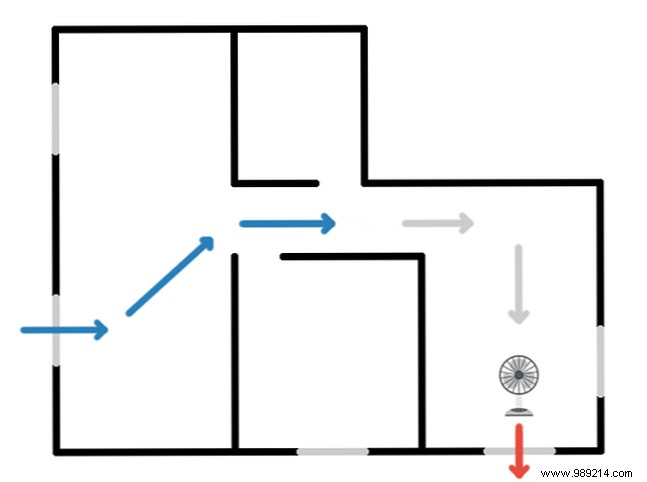
Simply open two windows, one on each end of your house, and point your floor fan directly at one of them. Put it on the highest power. This should expel enough air to create a pressure differential. If you have multiple floor fans, place them at choke point locations (eg a door) and use them to create a stronger unidirectional flow.
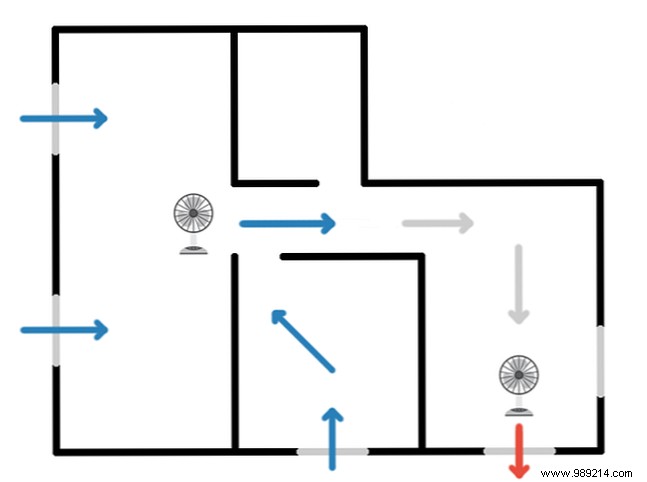
Pro Tip #1: If you are very hot and need immediate relief, take a cool shower and then stand in front of the fan. The evaporative effect will cool you down.
Pro Tip #2: Don't have time to take a bath? Dip her wrists (and feet) in a bowl of cold water (or run them under the faucet) to draw heat from her veins and circulate cold blood throughout her body.
Here's something you may not have known:it's not so much the heat That makes you feel uncomfortable as is the humidity (the amount of water vapor in the air).
As the humidity increases, it becomes more difficult for your sweat to evaporate. If sweat can't evaporate, your body can't regulate its temperature either, so you feel humid and hot. In fact, the difference between “normal” and “humid” air can make you feel up to 20 degrees warmer.
And it's not just humidity that makes you uncomfortable, it can also cause health problems and property damage 4 Health Benefits of Temperature and Humidity in the Home 4 Health Benefits of Temperature and Humidity humidity in the house Did you know that there are health benefits? of using smart home products? It's okay. One or two smart purchases could drastically improve your quality of life at home. Read more.
The ideal humidity for summer temperatures is somewhere between 45 and 55 percent . However, some people can still be comfortable with humidity between 30 and 60 percent. Aim for 50 percent.
If you're not sure where your home falls, get a hygrometer (a thermometer to measure humidity). They are very cheap, usually around $10, but offer a lot of value. Moisture control is one of the best ways to maximize comfort, prevent mold growth, improve sleep, and mitigate property damage. It will pay for itself many times over in the long run.
ThermoPro TP50 Digital Hygrometer Indoor Thermometer Humidity Monitor with Temperature Humidity Gauge ThermoPro TP50 Digital Hygrometer Indoor Thermometer Humidity Monitor with Temperature Humidity Gauge Buy Now on Amazon $10.99 AcuRite 00613 Humidity Monitor with Indoor Thermometer, Digital Hygrometer and AcuRite 00613 Humidity Gauge Indicator Humidity Monitor with Indoor Thermometer, Digital Hygrometer, and Humidity Gauge Gauge Buy Now On Amazon $11.99
ONE dehumidifier It's the fastest and most efficient way to reduce moisture and increase comfort. If your home is regularly above 50 percent humidity, you should consider getting one. If your home is regularly above 70 percent humidity, you need to get one.
Check out our guide to buying a dehumidifier for detailed advice:
Frigidaire 70 Pint Dehumidifier with Effortless Humidity Control, White Frigidaire 70 Pint Dehumidifier with Effortless Humidity Control, White Buy Now On Amazon $369.99 Keystone KSTAD70B 70 Pt. Dehumidifier Keystone KSTAD70B 70 Pt. Dehumidifier Buy Now On Amazon $219.03
Swamp cooler, desert cooler, and wet air cooler are all terms for the same device:an evaporative cooler. . An evaporative cooler is basically a closed water tank with a fan built into the side.
When water evaporates, it does so by absorbing heat from the air and changing from a liquid to a gas. This causes the air above the water to drop in temperature. Blow in cold air, suck in ambient air, and now you have a mechanism for cooling a room.
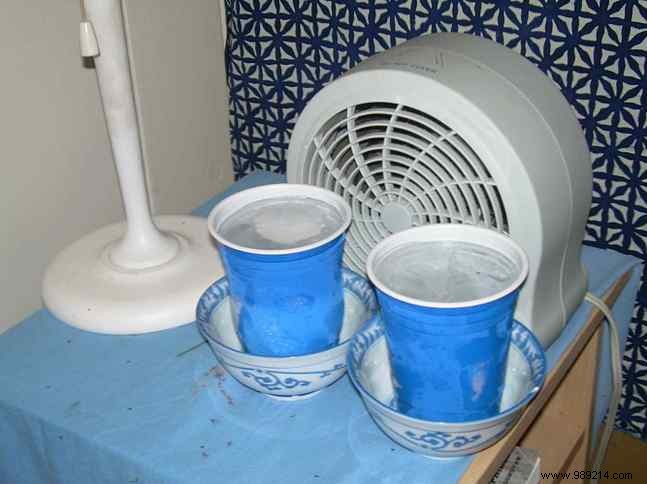
Commercial evaporative coolers are expensive, some can even cost more than an air conditioner! So we recommend trying a DIY solution first, which can be very cheap:
You can make it more sophisticated by creating an actual box with a built-in fan and a way to discharge the hot water and refill it with cold water and ice. But I leave it to you and your creativity..
The rate of evaporation depends on the humidity. If your home is already humid, the water from the evaporative cooler won't evaporate as quickly, greatly reducing its effectiveness.
Also, the water in an evaporative cooler doesn't just disappear, it ends up in the air itself. This means it increases humidity, and humidity can make you feel warmer even as the temperature drops.
Therefore, evaporative cooling is best in dry climates, ideally deserts. As a general rule of thumb, if your home is naturally under 40 percent humidity all the time, an evaporative cooler might be a viable solution. If your climate is extremely dry, the extra moisture might even help you sleep better.
In addition to lowering the indoor temperature, you should do everything you can to prevent heat from entering your home. Unfortunately, the sun is a large and strong adversary, not easily defeated.
If you want a cheap and easy solution, get thermal blackout curtains . These curtains are made from a material designed to block out as much sunlight and heat as possible. Lighter colors are better than darker ones (white reflects light while black absorbs light).
Cold showers are great for cooling off, and they're even better with the U by Moen Smart Shower. With it, you get seamless temperature control, smartphone notifications, and the ability to prepare, start, or pause your shower with an app.
Incandescent bulbs generate a lot of heat, so consider swapping them out for cooler summer nights. While CFLs are the standard, LED bulbs may be a better option. Are LED bulbs worth buying for your home? Is it worth buying LED bulbs for your home? The light emitting diode (LED) bulb has only just started to become popular in the last decade. Here's what you need to know before you decide if LED bulbs are right for you. Read more.
Lastly, adequate water intake is crucial! Your body cells need to be well hydrated to regulate body temperature. And dehydration not only makes you feel hotter, it can also lead to heat exhaustion and heat stroke.